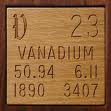Vanadium is a trace element abundant in soils throughout the world. It has been found a useless element especially to productive plants like corn, soybean, tomatoes and ornamental plants like impatiens and petunias.
The uselessness of Vanadium was discovered by a soil scientist Alan Olness of the Agricultural Research Service, US Department of Agriculture. Vanadium “impersonates” or replicates phosphorus and can confuse a plant into it instead of phosphorus.
“The hunger goes away but the nutrients never arrive,” said Olness. “Phosphorus is an essential nutrients plants need for growth, plants may have only two or three time windows during which they can take in phosphorus. If they fill up vanadium instead, they miss out on phosphorus because their root cells can’t tell them apart.” Olness stress out.
Their plant growth development and yields suffer. The more vanadium, the more the plant growth slows down and the lower the yield. For ornamental plants, the slowdown could results in less beauty and hardiness.
Standard soil tests don’t measure vanadium. However, it can measure the ratio of vanadium to soil phosphorus and other nutrients. Soil with very high in vanadium could lead to higher phosphorus recommendations and vice versa.
 The test can identify soil with so high of vanadium and boosting the soil with phosphorus would not might be economical. So farmers or gardeners might switch to other crops that need less phosphorus or a plant that can neutralize vanadium without any problem.
The test can identify soil with so high of vanadium and boosting the soil with phosphorus would not might be economical. So farmers or gardeners might switch to other crops that need less phosphorus or a plant that can neutralize vanadium without any problem.
According to Alan Olness, the soil scientist vanadium immunity can be bred into plants, recently they have found a soybean variety that is rather unaffected by vanadium. This provide some hope to researchers that they can extend the ability of this variety to other crops.